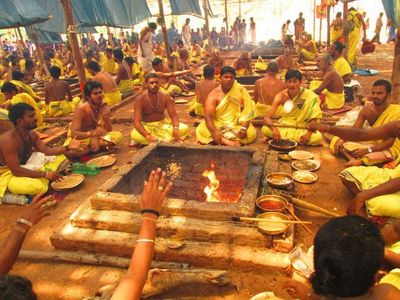|
Purva or Karma Mimansa Darshan (Chapters 12, verses 2731) is biggest darshan and was founded by Rishi Jamini in 4th century BC. Karma Mimansa has several sub-schools viz. Prabhakara sub-school & Bhatta sub-school (of 7th century BC). Karma Mimansa refers to examination of Vedic texts and stressed on Karmakanda (rituals) based on Vedas. It held that Vedas are eternal, authorless, and dharma means rituals & social duties. Ethics for this life and efficacious action for heaven (स्वर्ग) cannot be derived from sense-perception, and can only be derived from experience, reflection and understanding of past teachings. The ultimate aim of Karma Mimansa is achieving heaven. Deeds (कर्म) without aspiring for fruits and spiritual knowledge are means to get Heaven. By mastering the above two means, past deeds extinguish and man become liberated. Karma Mimansa has three parts viz. tools of knowledge (Perception, Inference, Analogy & Comparison, word, Postulation and non-perception), Spiritualism and Duty decider. Yajna (also called karma) are done for the achievement of a fruit like 'Heaven. Yajnas are performed on daily, fortnightly, monthly, annually and once in life time. Agnihotra is the homa done thrice a day. Yajna means worshipping, sacrifice & offering. The main constituents of Yajna are desire of doer (bhāvana), learning (svādhyāya), rites involved (karma), offerings i.e. Yaga-sacrifice, Dana-giving & Homa-offerings in fire (tyāga), devata and the results (phala). The ingredients used in a yajna are called dravya. Samskāra is a rite that involves mantra. There are forty samskāras or rites performed in one’s lifetime. The three parts of Karma Mimansa as under:
The main features of Karma Mimansa: continued........
Reference:
3. http://aryamantavya.in/darshan/vaisheshik-darshan/3 4. www.hindupedi.com
0 Comments
Leave a Reply. |
Archives
July 2024
Categories |


 RSS Feed
RSS Feed